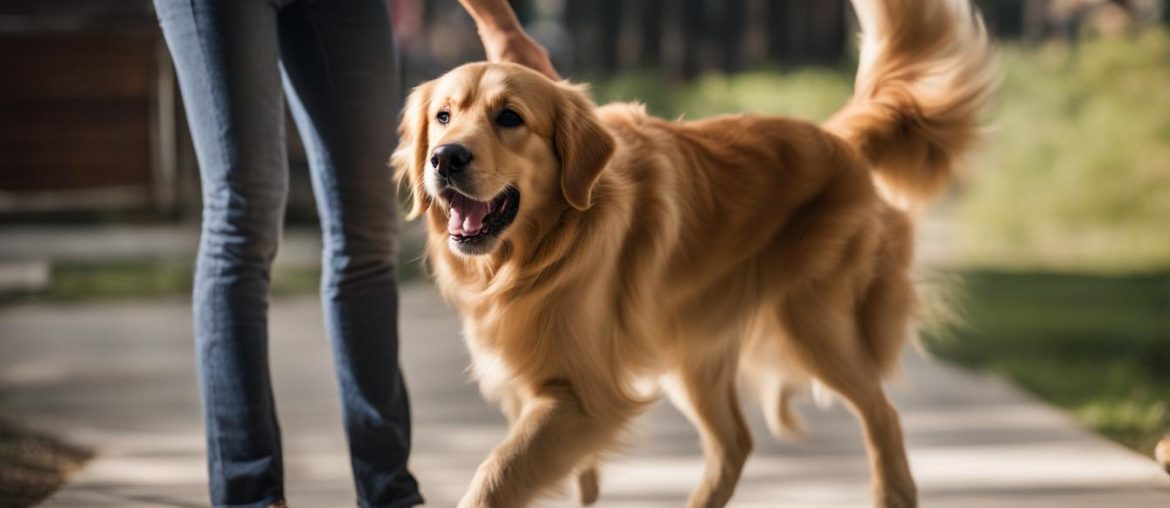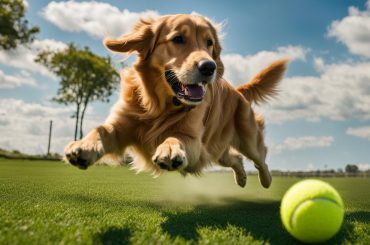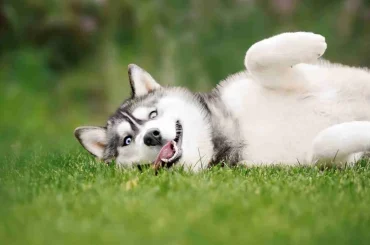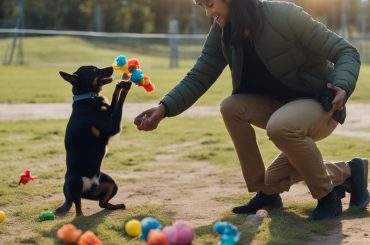Teaching a dog to shake is a fun and impressive trick that can be easily taught using positive reinforcement training techniques. By following these simple steps, you can train your dog to offer their paw for a shake command. The trick is to patiently wait for your dog to paw at your hand, rewarding them with treats and praise.
Key Takeaways:
- Teaching a dog to shake strengthens the bond between you and your dog.
- Positive reinforcement techniques are effective for shake training.
- Having high-value treats and a clicker can enhance the training process.
- Gradual progression and proofing help solidify the shake behavior.
- If your dog struggles, be patient and keep training sessions positive.
The Importance of Teaching Shake

Teaching a dog to shake not only provides a fun and impressive trick to show off, but it also plays a significant role in improving their overall obedience and behavior. The step-by-step training process using positive reinforcement techniques helps strengthen the bond between you and your dog. It builds their confidence and provides mental stimulation, making them more responsive and obedient in other aspects of training.
Positive reinforcement training for dogs has proven to be highly effective and humane. By rewarding desired behaviors, such as offering their paw for a shake, you are reinforcing the behavior you want to see more of. This training method creates a positive association with the command and encourages your dog to willingly perform the trick. It also helps in shaping other desirable behaviors and makes the learning process enjoyable for both you and your furry friend.
Enhancing Dog Obedience
Dog obedience training is essential for a harmonious and well-behaved pet. Teaching your dog to shake is a valuable addition to their obedience repertoire. It requires focus and concentration, helping your dog develop self-control and impulse management. By mastering the shake command, your dog learns to listen to your cues and respond accordingly, enhancing their overall obedience. This skill can be further built upon to teach more advanced tricks and commands, creating a well-rounded and disciplined canine companion.
| Benefits of Teaching Shake | How It Improves Dog Behavior |
|---|---|
| Strengthens the bond between you and your dog | Builds confidence and trust in your dog |
| Provides mental stimulation | Increases responsiveness and obedience |
| Enhances overall obedience | Develops self-control and impulse management |
| Can be built upon for more advanced tricks | Creates a well-rounded and disciplined canine companion |
Teaching your dog to shake is a rewarding endeavor that not only showcases their intelligence and willingness to learn but also improves their behavior and obedience. By using positive reinforcement training techniques and following a step-by-step approach, you can successfully teach your dog to offer their paw for a shake command. So grab some treats, get ready to make some memories, and watch your furry friend master this impressive trick!
Preparing for Shake Training
In order to effectively teach your dog to shake, it’s important to be prepared and have the necessary supplies on hand. Here are some tips to help you get ready for your training sessions:
- Gather high-value treats: Choose treats that your dog finds particularly enticing and motivating. This could include small pieces of cooked chicken, cheese, or freeze-dried liver. Using high-value treats will help keep your dog engaged and eager to participate in the training.
- Get a clicker: Consider using a clicker as a training tool. The clicker makes a distinct sound that can be used to mark desired behaviors. It provides clear communication and helps your dog understand when they have done something right.
Having these supplies ready before beginning your shake training sessions will set you and your dog up for success. Remember to keep the training sessions short and positive, and always end on a positive note. Now let’s move on to the next section and learn the step-by-step process for teaching your dog to shake!
The Steps to Teach Shake

To teach your dog to shake, follow these simple steps:
- Start by holding out your hand to your dog at their eye level.
- Wait for your dog to paw at your hand. As soon as they do, click or praise them to mark the behavior.
- Quickly open your hand to give them a treat. This reinforces the action of shaking.
- Repeat these steps several times until your dog consistently paws at your hand.
- Next, you can increase the duration that your dog holds their paw on your hand. Gradually increase the time before giving the reward.
Remember to be patient and use positive reinforcement techniques throughout the training process. The click or praise should be timed to coincide with the desired behavior, and the treat should be given immediately after. This helps your dog associate the action of shaking with a positive outcome.
Consistency is key when teaching your dog to shake. Practice the training sessions regularly and reinforce the behavior in different environments. With time and patience, your dog will become proficient in offering their paw for a shake command.
Tips for Successful Shake Training
- Choose a quiet and distraction-free environment for training sessions.
- Use high-value treats that your dog finds particularly enticing.
- Keep training sessions short and positive to prevent frustration.
- If your dog doesn’t offer their paw, you can gently nudge their paw closer to your hand or lift it into your hand yourself.
- End each training session on a positive note, even if it means asking your dog to perform a simpler command like sitting.
By following these steps and tips, you can successfully teach your dog to shake. Remember to be patient, celebrate small successes, and enjoy the bonding moments created through training.
Adding Verbal Cue
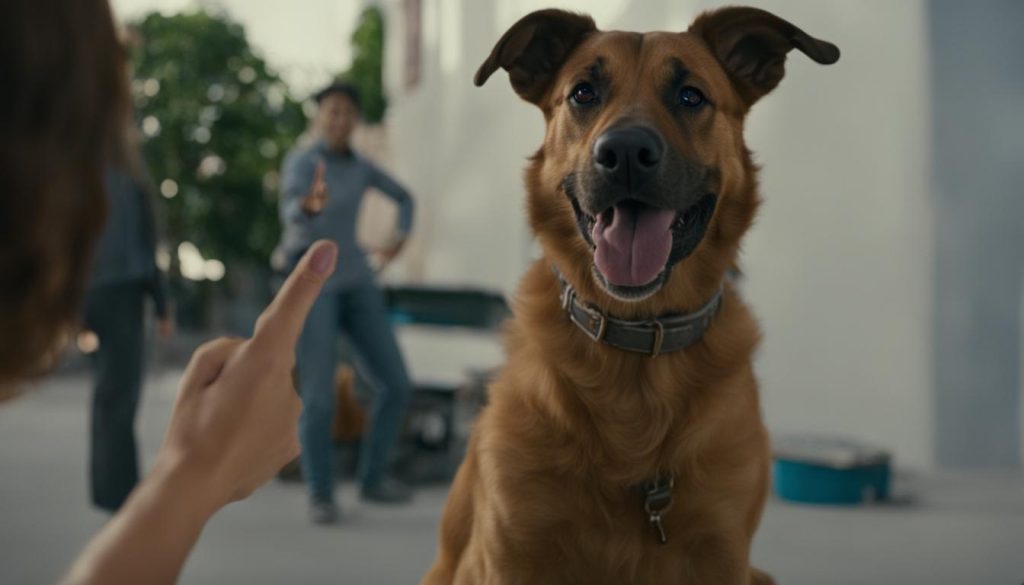
Now that your dog consistently offers their paw for a shake, it’s time to add a verbal cue to the behavior. This will help your dog understand that the command “shake” is associated with the action of offering their paw. Introduce the verbal cue right before your dog makes contact with your hand, saying “shake” in a clear and consistent tone.
When your dog successfully shakes their paw after hearing the verbal cue, make sure to praise them and provide a treat as a reward. This positive reinforcement will strengthen their understanding of the verbal cue and reinforce the desired behavior. Practice this step repeatedly, ensuring that your dog consistently responds to the verbal cue “shake” before moving on to the next level of training.
Remember to be patient and consistent during this process. Dogs learn through repetition, so consistent training sessions will help them understand and respond to the verbal command more effectively. With time and practice, your dog will become proficient in shaking their paw upon hearing the cue “shake”.
Tips for Adding a Verbal Cue
Here are a few tips to keep in mind when adding a verbal cue to your dog’s shake behavior:
- Be clear and consistent with your vocal command. Use the same word, such as “shake” every time you want your dog to offer their paw.
- Ensure your timing is accurate. Say the verbal cue right before your dog makes contact with your hand to create a strong association between the command and the action.
- Use a positive tone and praise your dog when they successfully shake their paw after hearing the verbal cue. This will reinforce the desired behavior and motivate them to continue offering their paw.
- Practice in different locations and with varying distractions to help your dog generalize the behavior. This will ensure they understand the command “shake” in different environments and situations.
By incorporating a verbal cue, you can enhance your dog’s ability to perform the shake behavior on command. With consistency and positive reinforcement, your dog will be able to impress and delight you with their newfound trick.
Shaking with Each Paw
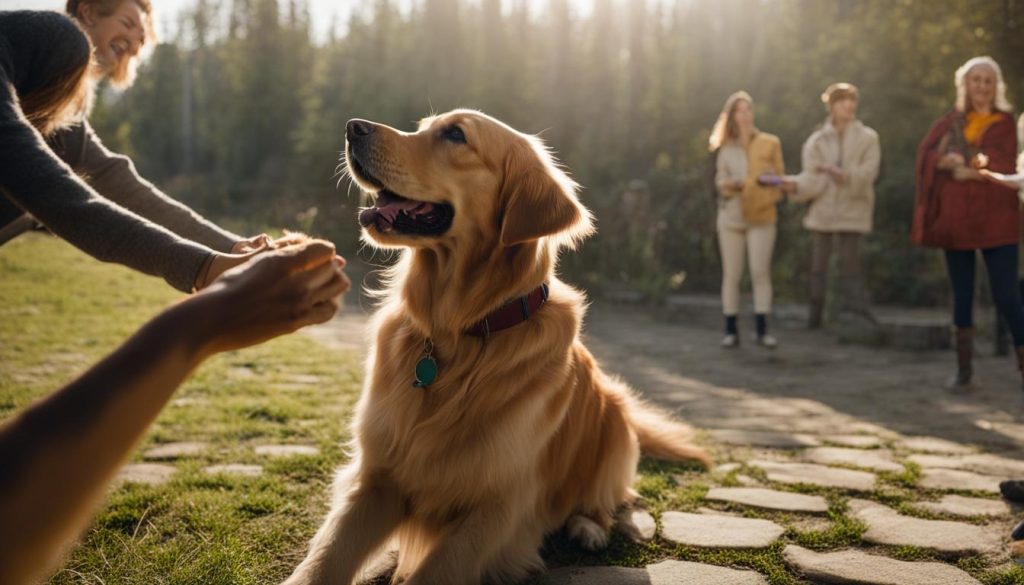
Teaching a dog to shake is a delightful trick, but it’s important to remember that dogs don’t generalize this behavior across their paws. To ensure that your furry friend can perform the trick reliably, it’s necessary to teach them to shake with both their right and left paw separately.
To achieve this, you can use the same training steps described earlier. However, when rewarding your dog, only provide the treat when they offer the paw that is closest to your hand. If they happen to offer the “wrong” paw, simply wait quietly until they offer the correct paw and then reward them.
By practicing shake with both paws, you’ll ensure that your dog develops the ability to perform the trick using either paw on command. This will make their repertoire of tricks even more impressive and versatile.
Table: Teaching Shake with Each Paw
| Step | Action |
|---|---|
| 1 | Hold out your hand |
| 2 | Wait for your dog to offer their paw closest to your hand |
| 3 | Click or praise their action |
| 4 | Give them a treat |
| 5 | Repeat the steps, rewarding only the correct paw |
Practice shake with each paw during your training sessions to ensure your dog’s success and confidence in performing the trick. With patience and consistency, they will learn to offer both paws with ease, impressing everyone with their shake skills.
Gradual Progression and Proofing

As you and your dog progress in shake training, it’s important to gradually increase the difficulty of the exercises. This helps solidify the behavior and ensures that your dog can perform the trick reliably in various situations. One way to do this is by increasing the levels of distraction during your training sessions. Introduce mild distractions such as toys or other people in the vicinity while asking your dog to shake. This will help them learn to focus on your command even when there are other things happening around them.
Another important aspect of progressing in shake training is to maintain high rates of reward. As the behavior becomes more familiar to your dog, it’s essential to continue reinforcing it with rewards such as treats and praise. The high rate of reward serves as positive reinforcement and encourages your dog to offer their paw consistently. Remember, consistency is key in dog training, so make sure to practice shake regularly to reinforce the behavior.
Proofing the Behavior
Proofing the behavior means teaching your dog to perform the shake trick in different contexts and situations. This ensures that they can respond to the command regardless of the environment or circumstances. To proof the behavior, practice shake in different locations such as parks, streets, or even in the presence of other animals. This will help your dog generalize the trick and understand that the shake command applies wherever they are. It’s also beneficial to have other people ask your dog to shake, reinforcing their understanding of the trick from different individuals.
Remember to be patient and persistent during this phase of training. It may take some time for your dog to fully grasp the concept of shake in various situations, but with consistent practice and reinforcement, they will become more confident and reliable in performing the trick. Celebrate each success and continue to challenge your dog with new scenarios to further improve their shake skills.
| Training Tip | Troubleshooting |
|---|---|
| Use a variety of rewards during shake training to keep your dog motivated and engaged. Experiment with different types of treats or incorporate playtime as a reward. | If your dog is having difficulty offering their paw, try luring them by holding a treat close to their paw and rewarding them when they make contact with it. Gradually fade out the lure to encourage them to offer their paw freely. |
| Practice shake in different rooms of your house to help your dog understand that the command applies regardless of the location. This will also help them generalize the behavior. | If your dog gets distracted during training sessions, try moving to a quieter or more secluded area to minimize distractions. Gradually reintroduce distractions as they become more proficient in shake training. |
| Keep training sessions short and enjoyable for your dog. Aim for multiple short sessions throughout the day rather than one long session. This will prevent your dog from becoming bored or overwhelmed. | If your dog consistently offers the wrong paw during shake training, gently ignore their incorrect response and wait for them to offer the correct paw. Reward and praise them when they do. |
Training Tip
- As you progress in shake training, consider adding variations to the trick. For example, you can teach your dog to give a high-five instead of a regular shake.
- Always end the training session on a positive note, even if your dog is not performing perfectly. Celebrate their progress and efforts.
Training Tips and Troubleshooting
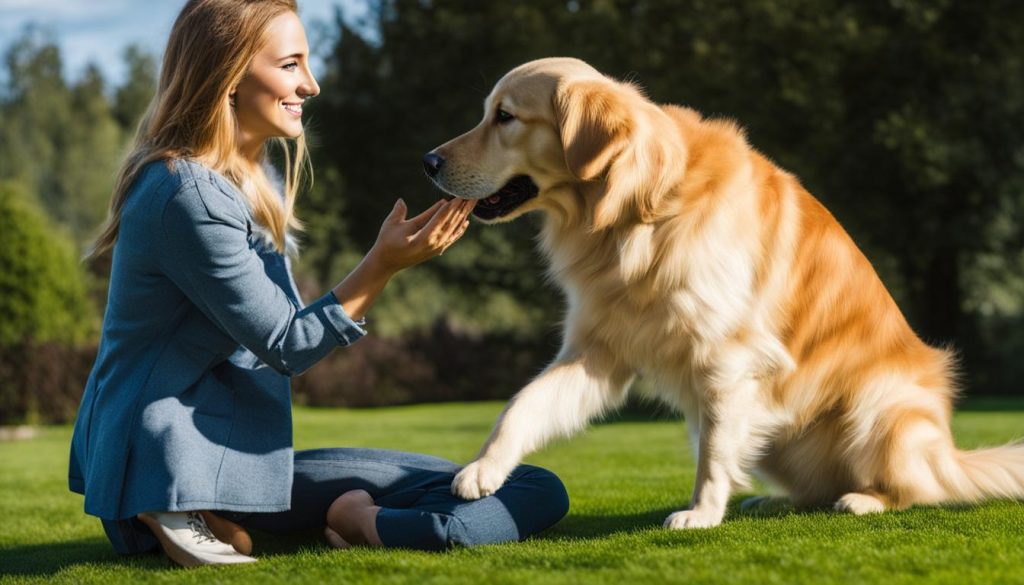
When teaching your dog to shake, it’s important to keep a few training tips in mind and be prepared for any challenges that may arise along the way. Here are some helpful tips and troubleshooting strategies to help you navigate the training process:
1. Be Patient and Consistent
Training your dog to shake takes time and patience. It’s important to be consistent with your training sessions and practice regularly. Keep the sessions short and positive, focusing on rewarding your dog for their efforts and progress. Remember, each dog learns at their own pace, so be patient and celebrate small successes along the way.
2. Use Positive Reinforcement
Positive reinforcement is the most effective training technique for teaching tricks to dogs. Make sure to reward your dog with treats, praise, and affection when they offer their paw for a shake. This will help reinforce the behavior and motivate your dog to continue learning. Avoid using punishment or force, as it can create fear and anxiety in your furry friend.
3. Troubleshooting Challenges
If your dog seems confused or doesn’t offer their paw, you can gently nudge their paw closer to your hand or even lift it into your hand yourself. This can help them understand what you’re asking for. Additionally, if your dog gets distracted during training, try practicing in a quiet and familiar environment before gradually increasing distractions. Remember to end each training session on a positive note, even if it means asking your dog to perform a simpler command like sitting.
| Challenge | Troubleshooting Strategy |
|---|---|
| Difficulty offering paw | Gently nudge or lift their paw |
| Distracted during training | Practice in a quiet environment and gradually increase distractions |
| End of session frustration | Ask for a simpler command and end on a positive note |
Remember, teaching your dog to shake is a journey that requires time, patience, and positive reinforcement. By following these tips and troubleshooting strategies, you can overcome challenges and successfully train your dog to offer their paw for a shake command. Enjoy the process and have fun bonding with your furry companion!
Taking Shake to the Next Level
Now that your dog has mastered the shake command, you can take their training to the next level by teaching them to wave. This advanced trick builds on the foundation of shaking, adding an extra level of complexity and impressiveness to your dog’s repertoire. By following these steps, you can expand your dog’s trick skills and continue to strengthen your bond.
To begin teaching your dog to wave, start with the shake command. Once your dog offers their paw, use a verbal cue like “wave” and gently lift their paw higher. As your dog lifts their paw higher in response to the cue, reward them with treats and praise. Repeat this step until your dog starts to associate the “wave” cue with lifting their paw higher.
Gradually, reduce the physical guidance and rely solely on the verbal cue. When your dog consistently raises their paw higher in response to the “wave” command, reward them generously. Practice this step in different locations and gradually introduce distractions, ensuring that your dog remains focused on the task at hand.
| Trick | Description |
|---|---|
| Shake | Teaching your dog to offer their paw for a shake command. |
| Wave | Building on the shake command, teaching your dog to lift their paw higher in response to a verbal cue. |
Remember, the key to successful training is consistency, patience, and positive reinforcement. Celebrate every small achievement and always end each training session on a positive note. With time, practice, and dedication, your dog will continue to amaze you with their newfound trick skills.
Wrapping Up
Teaching tricks to dogs is an exciting and fulfilling endeavor that strengthens the bond between you and your furry friend. Throughout this step-by-step dog shake training guide, I have outlined effective dog training techniques using positive reinforcement. By following these techniques, you can successfully teach your dog to offer their paw for a shake command.
Remember to be patient and consistent in your training sessions. Celebrate each success along the way, no matter how small, and always end on a positive note. The key is to create a rewarding and enjoyable learning experience for your dog.
Through the process of teaching your dog to shake, you are not only teaching them a fun trick, but you are also providing mental stimulation and improving their overall obedience. So grab some high-value treats, gather your supplies, and embark on this wonderful journey of teaching your dog new tricks!
FAQ
Is it difficult to teach a dog to shake?
Teaching a dog to shake is not difficult, but it does require patience and consistency. By following the step-by-step training process and using positive reinforcement techniques, you can successfully teach your dog to shake.
What rewards should I use during shake training?
It’s important to use high-value treats or rewards that will motivate your dog. Find out what treats your dog loves the most and use those during training. You can also use a clicker, a small device that makes a clicking sound to mark desired behaviors.
How long does it take to teach a dog to shake?
The time it takes to teach a dog to shake can vary depending on the individual dog and their learning pace. Some dogs may pick up the trick quickly, while others may take more time. Consistency and regular practice will help speed up the training process.
Can I teach my dog to shake with both paws?
Yes, you can teach your dog to shake with both their right and left paw separately. Dogs don’t generalize behaviors across their paws, so it’s important to train them to shake with each paw individually.
What should I do if my dog doesn’t offer their paw?
If your dog doesn’t offer their paw, you can nudge their paw closer to your hand or even lift it into your hand yourself. Be patient and continue to reinforce the behavior with treats and praise when they offer their paw.
Can I teach my dog more tricks after they learn to shake?
Absolutely! Once your dog has mastered shaking, you can expand their trick repertoire by teaching them other tricks, such as waving. Building on the foundation of shaking, you can continue to teach your dog new and impressive behaviors.


